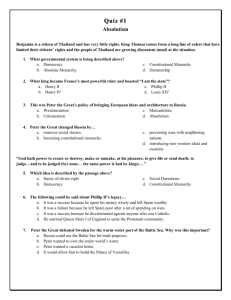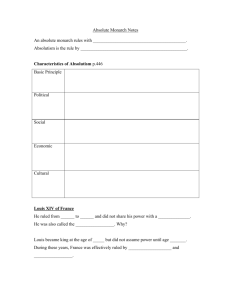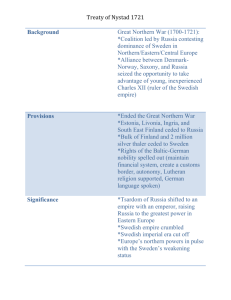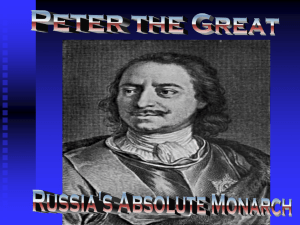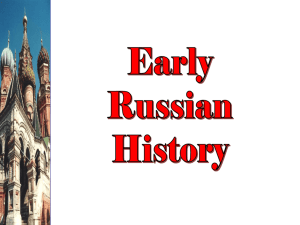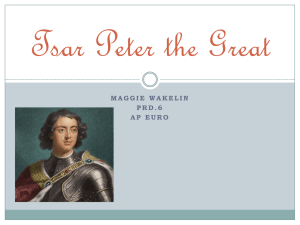Absolutism in Eastern Europe 1600 -1725
advertisement
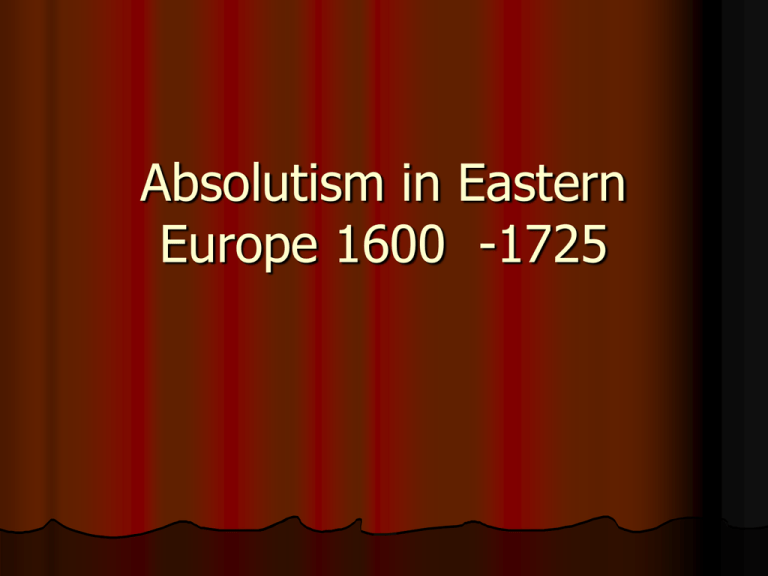
Absolutism in Eastern Europe 1600 -1725 Three Declining Empires Eastern Europe in 1648 The HRE, the Republic of Poland and the Ottoman Empire occupied the area from the French border to Russia All three empires were declining. Each lacked a strong central authority and efficient system of government Each of the declining empires contained diverse ethnic and language groups The Holy Roman Empire The reformation left the HRE religiously divided between Catholics and Protestants The Thirty Years War left the HRE polically divided into 300 independent states The empire had an elected emperor who had no imperial army, revenues or central authority Led by the Habsburgs and the Hohenzollerns, Austria and Prussia gradually emerged as leading German states. The Republic of Poland On a map of Europe in 1660, Poland appears to be a large, unified country. In reality, the king of Poland was elected and had restricted powers. Poland did have a central diet. However, action required the unanimous consent of each aristocratic member, any member could break up the diet at any time. This lack of central power created a power vacuum, leaving it vulnerable to stronger nations The Ottoman Empire Led by Suleiman the Magnificent, the Ottomans threatened Vienna In the middle of the seventh century, a series of ambitious rulers revitalized the Ottoman. In 1683 a powerful Turkish army besieged Vienna Austrian forces reinforced by Poles and Germans repelled the Turks. This marked the beginning of the Ottoman decline The Habsburgs The revival of Habsburg power One of the oldest dynasties in Europe (1400). Most of the HRE emperors were Habsburgs Power declined following the 30 yrs war and the extinction of the Habsburg line in Spain Despite such defeats the Habsburgs maintained power in Austria, Bohemia and Hungary. The treaty of Utrecht gave Habsburgs control of Naples, Sardinia and Milan in Italy and the Spanish Netherlands The Hapsburg dynasty was able to embrace a large no. of ethic groups through the Catholic faith Charles VI and the Pragmatic Sanction Charles VI (1711-1740)did have a male heir To ensure secession for his daughter, the Pragmatic Sanction was created. It stated that the territories of the Habsburg empire was indivisible and that Maria Theresa would inherit the land England and other foreign powers forced Charles to make a number of concessions before agreeing to the Pragmatic Sanction. Charles died believing he had guaranteed the peace and integrity of his realm. Test Tip: Charles VI devoted a lot of time winning European approval for the Pragmatic Sanction, you should know and understand the purpose of it. The Rise of Prussia The Hohenzollerns of Brandenburg-Prussia Brandenburg was a small state located between the Oder and Elbe rivers with its center in Berlin The ruler was one of seven princes who elected the Holy Roman emperor The Hohenzollern family became the hereditary rulers in 1417 17th century, the Hohen. Inherited Cleves, land on the Rhine and the duchy of Prussia on the Baltic. These diverse and geographically separated territories had no natural boundaries, few resources and a pop. Of 1.5 millionHistory of Prussia: Kings and Leaders / Hohenzollern - YouTube Frederick William I Hohenzollern castle Frederick William, The Great Elector 1640-188 Although weak and scattered, the Hohen. Territory was the second largest in the HRE Known as the great elector, Frederick began to forge the territories into a strong power. He wanted take part in the Balance of Power politics Demanded and received loyalty from the Junkers (German land owners). In exchange they gained total control over their serfs Frederick William I 1713-1740 Like the great elector, Frederick William I was determined to build a strong powerful army. The military doubled in size to 80,000, which made it the 3rd or 4th largest in Europe The military became the center of Prussian life and culture. “ Prussia is not a state that possesses an army, but an army that possesses a state”. Russia Before Peter the Great Isolation Russia was geographically isolated from the rest of Europe. Sweden prevented Russia from reaching the Baltic Sea while the Ottoman Empire prevented Russia from reaching the Black Sea Russia was culturally isolated from the rest of Europe. The ideas of the Renaissance and Reformation and all the discoveries of the Age of Exploration and scientific revolution scarcely affected Russia Russia to 1700 Muscovy (Russia) and surrounding territories, 1533 Peter the Great 1682-1725 Peter the Great Modernizing Russia Had recognized that Russia had fallen behind western Europe. Determined to learn from rivals, he visited Holland and England, where he toured shipyards, viewed military equipment and observed western customs. Returned to Russia with vision to grow it into a great power, he started with the army and navy. Peter the Great - YouTube He did not limit changes to military and technology. He improved agriculture with introduction of the potato, strengthened economy by importing skilled workers, liberated Russian women by allowing them to appear in public without veils. In a famous and resented act he forced nobles to shave their traditional long beards. Defeating Sweden The Thirty Years’ War left Sweden in control of the Baltic’s entire eastern shore. In 1700, Peter ordered his army to end Sweden's dominance of the Baltic. The Great Northern War between Sweden and Russia lasted from 1700-1721 After suffering initial defeats from King Charles XII, Peter eventually won the war, thus gaining access to warm water routes on the Baltic This defeat contributed to Sweden's decline as a major European power, while Russia was stepping it up. Building St. Petersburg Began building in 1703. It was named after his patron saint, St Petersburg would be “ a great window for Russia to look at Europe” St. Petersburg quickly became a symbol of Peter the Great’s new and more powerful Russia Controlling the Boyars The Boyars were the old nobility who supported traditional Russian culture Peter ordered the Boyars to shave their beards, build elaborate homes in St. Petersburg and serve in the army of civil administration Exploiting the Serfs Russia’s peasants did not enjoy the benefits of Peter the Great’s reforms. Instead they were conscripted into the army and forced to build St. Petersburg In central Europe, serfs were bound to the land. In Russia serfs could be sold apart from the land. This allowed nobles to force serfs to work in mines and factories The Beach Boys - YouTube Evaluating Peter the Great He provided a model of how an energetic and ruthless autocrat would change a nation. He successfully transformed Russia into a greta power that would play an increasingly important role in European history His policies increased the disparities between the nobles and the peasants. Millions of exploited serfs formed an estranged class that did not share in Russian society Rudolph The Red Nosed Reindeer The Island Of Misfit Toys YouTube Test Tip Peter the Great’s momentous reign has been the subject of numerous multiple choice questions and free response essays on the APEURO exam. The peter the Great’s successes include his program of modernization, construction of St. Petersburg and victory over Sweden in the Great Northern War. However, the Russian economy continued to exploit serfs.

